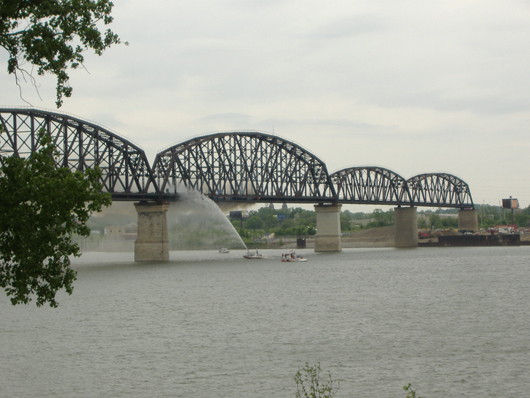
LOUISVILLE, Ky. (AP) – In more than 40 years since the last trains rumbled across its rusty span, the Big Four Bridge has stood as a curiosity on Louisville’s downtown waterfront.
There was no apparent way to get on or off the bridge to nowhere. And for years, the fate of the aging structure, rising from a blighted industrial waterfront, was a subject of perennial civic debate.
Some said it should be torn down or turned into a walkway. Others suggested building apartments atop it. In the late 1980s, Costa Rica asked if it could buy, disassemble and ship the bridge to Central America. None of it happened.
But on Thursday, the span first used in 1895 was finally reborn as Louisville Mayor Greg Fischer lifted the gates for the first time to let hundreds of cyclists, joggers and curious residents rush up the spiral ramp onto the new Big Four pedestrian and bicycle bridge, initially envisioned in 1991.
“I’ve been waiting for this for 20 years,” said Don Eastridge, 67, who wore a Vietnam Veteran’s hat and puffed a pipe as he enjoyed the view of Waterfront Park from the middle of the Ohio River. “I think we’ve got a jewel here. … Louisville, I’m proud of you.”
Officials had pumped it up as the most anticipated attraction since the city began converting its old industrial waterfront into a downtown river park. And judging from the nearly 400 people who waited with bikes, dogs and cameras to take the 10-minute walk across the river, they were right.
There were grandparents in wheelchairs, hipsters pedaling fixed-gear bikes, city workers, parents toting young children and a group of cyclists dressed in turn-of-the century garb with one riding a high-whee; antique bicycle. And they all raved about the bridge and its views.
As they posed for photos, ate lunch on benches, made calls (“I’m on the new bridge!”) and stopped to tweet, many said its completion underscored how far the waterfront, and Louisville, had come.
“It was wonderful,” said a breathless Lynn Luking, a 58-year-old retired teacher on a bike who was the first across and declared it worth the wait.
Retired railroad engineer Gene Younger, 60, said the bridge once exited in part to a railyard where the Louisville Bats’ Slugger Field is located. He said he’s heard just about every idea for its use over the years and every urban myth about the bridge, including that there were bodies buried in the concrete pillars.
The new bridge honors the workers who died building it. A plaque near the entrance memorializes the 42 workers who died in its construction beginning in 1888, including 22 who died in an 1893 collapse that ranked as one of the nation’s worst bridge disasters at that time.
Still, the bridge to nowhere still won’t go anywhere for a few months. The ramp on the Kentucky side is complete, but Indiana’s approach won’t be finished until this summer, Jeffersonville officials said.
For those who walked to the other side, the partially completed Indiana ramp could be seen descending into a neighborhood of vintage mansions mixed into apartment houses and shops.
Many predicted a retail revival in Jeffersonville near the bridge.
“I wish I would’ve bought 100 acres over there,” Eastridge said.
The Big Four project has cost about $20 million. Officials still want to raise nearly $2 million for decorative lighting. Across the river, Jeffersonville officials have lined up $10 million to pay for the Hoosier access.
On the Louisville side of the bridge Thursday just off River Road, Fischer joined Jeffersonville Mayor Mike Moore, former Louisville mayor and Lt. Gov. Jerry Abramson and David Karem, executive director of the Waterfront Development Corp., to mark the opening.
Fischer said the waterfront changes have “transformed the way we feel” about Louisville. He then jokingly predicted that, because the view is so nice, someone would propose on the bridge at sunset on Valentine’s Day.
Abramson also spoke, reminiscing about the jokes that truckers once made about the derelict waterfront as they passed on I-64 and about the time he got a call from the president of Costa Rica seeking to buy the span.
“I thought somebody was kidding me,” he said, noting that the city had to decline because it didn’t own the bridge.
Conversion of the bridge into a skyway was proposed in 1991 in the park’s original master plan devised by landscape architect and designer George Hargreaves of San Francisco.
Moore said that there were so many people present for the opening that he felt “like a greeter at Walmart on Black Friday.” Officials played the sound of a train chugging and blowing its horn before lifting the gates as crowds rushed up the walkway.
People leaned on the 54-inch railings for uncommon views of Towhead Island, the Tumbleweed Restaurant and the new marina just upriver. Down below were the grassy parks home to the summer Waterfront Wednesday concerts sponsored by public radio station WFPK.
Taking it all in as the crowds rolled past, Eastridge – who grew up in West Louisville and marveled at the stretches of green where blight once ruled – said the bridge’s completion “cements the park.”
“It really brings it all together,” he said.
___
Information from: The Courier-Journal, http://www.courier-journal.com
Copyright 2012 Associated Press. All rights reserved. This material may not be published, broadcast, rewritten, or redistributed.
AP-WF-02-08-13 1751GMT
ADDITIONAL IMAGE OF NOTE



